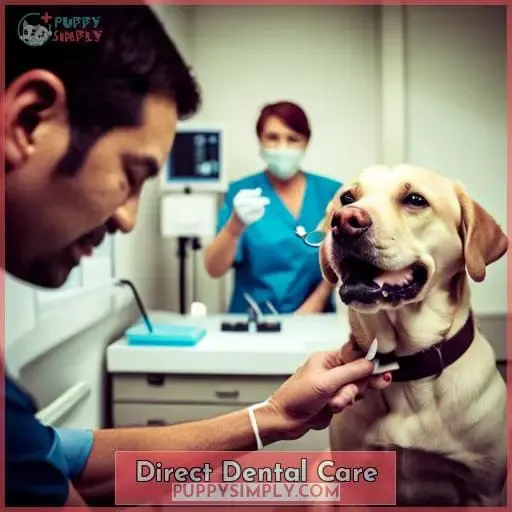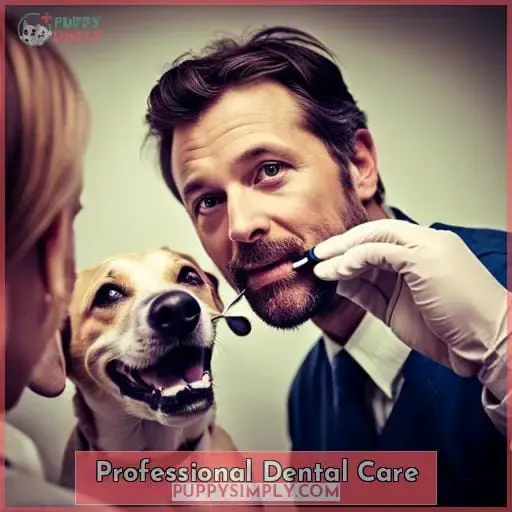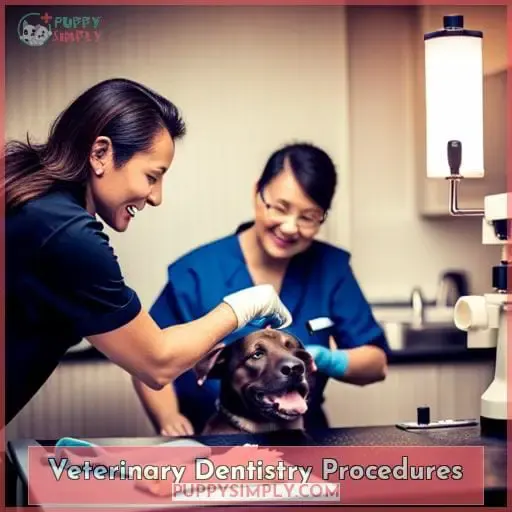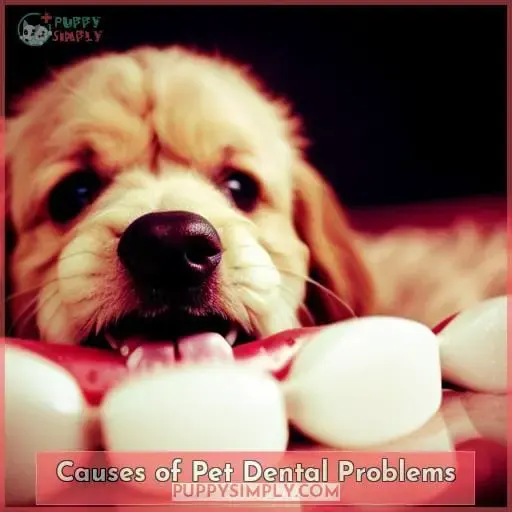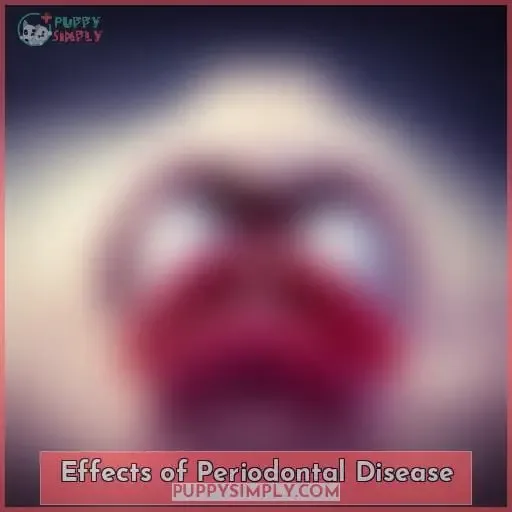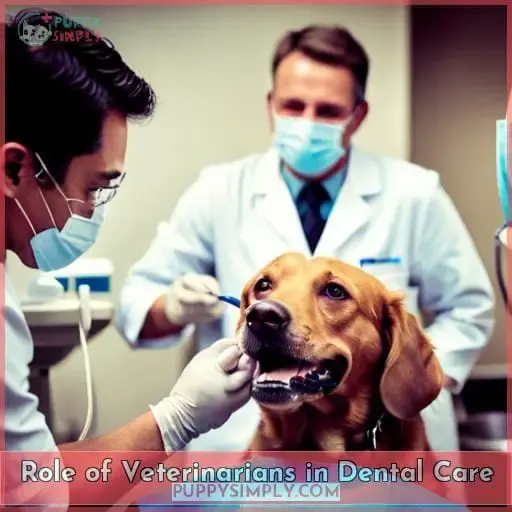This site is supported by our readers. We may earn a commission, at no cost to you, if you purchase through links.
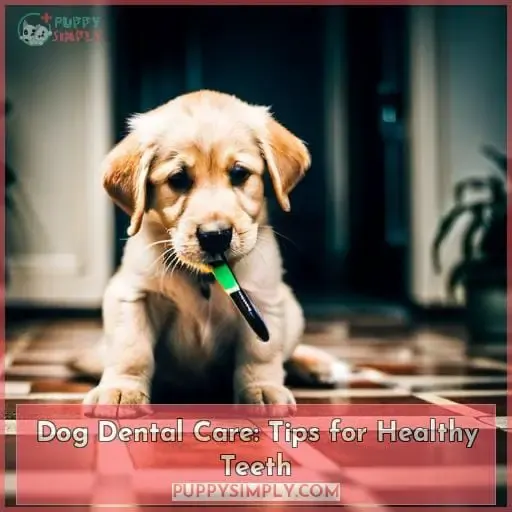 Looking to keep your dog’s teeth healthy and their breath fresh? Check out these tips for effective dog dental care.
Looking to keep your dog’s teeth healthy and their breath fresh? Check out these tips for effective dog dental care.
Brushing your pup’s teeth with flavored toothpaste is a great way to eliminate plaque buildup and prevent bad breath.
Additionally, professional cleanings by veterinarians are important in maintaining optimal oral health.
Discover more about the causes of dental problems in pets and the role of veterinarians in ensuring overall dental care for your furry friend.
Table Of Contents
Key Takeaways
- Brush your dog’s teeth regularly with a canine-specific toothpaste and brush or fingertip brush.
- Take your dog to the veterinarian for regular cleanings.
- Avoid giving your dog hard objects to chew on.
- Monitor your dog for signs of dental problems, such as bad breath, drooling, or difficulty eating.
Direct Dental Care
When it comes to direct dental care for your dog, two effective methods are brushing their teeth and using dog tooth wipes.
Brushing your dog’s teeth with a canine-specific toothpaste and suitable brush or fingertip brush can help remove plaque and tartar buildup.
Dog tooth wipes provide an alternative option for dogs resistant to brushing by removing plaque but may be less thorough than brushing.
Both methods contribute to maintaining good oral hygiene for your furry friend.
Brushing Your Dog’s Teeth
Tips for Healthy Teeth:
- Use dog-specific toothpaste and toothbrushes.
- Gradually train your dog for acceptance of teeth brushing.
- Aim to brush your dog’s teeth 2-3 times per week.
- Experiment with different flavors of toothpaste to find what your canine companion prefers.
Regularly brushing your dog’s teeth is an essential part of their oral health routine. Using specialized dental products designed specifically for dogs ensures effective cleaning while minimizing any discomfort or resistance from your furry friend.
Training techniques can help familiarize them with the process, making it easier and more enjoyable for both you and your pet. Remember to consult with a veterinarian regarding preferred flavors, recommended brushing frequency, and additional tips on maintaining proper canine dental care at home.
Dog Tooth Wipes
To maintain your dog’s oral hygiene, consider incorporating dog tooth wipes into their dental care routine. These wipes provide an alternative to brushing and are designed to remove plaque from your dog’s teeth.
While they may not be as thorough as brushing, they offer convenience and can be a suitable option for dogs that resist traditional brushing methods.
When using tooth wipes, it’s important to choose products specifically made for dogs and follow the frequency guidelines provided by the manufacturer. Training tips can also help overcome resistance when introducing tooth wipes into your dog’s dental care routine.
| Wipe Alternatives | Training Tips | Choosing Products | Overcoming Resistance |
|---|---|---|---|
| – Dog Tooth Wipes – Dental sprays | – Gradually introduce – Use flavored canine | – Look for products | – Be patient |
| – Dental gels – Water additives | – Associate positive toothpaste with appealing flavors | — Use treats during — Make it a positive | |
| experiences the wiping process experience |
It is essential to note that while using tooth wipes can contribute positively towards maintaining dental health in dogs, regular professional cleanings by a veterinarian should still be scheduled according to their recommendations.
Professional Dental Care
When it comes to professional dental care for your dog, regular cleanings by a veterinarian are highly recommended.
These cleanings ensure comprehensive care and address hidden dental issues that may not be visible during at-home practices.
It’s important to understand the persistence of tartar buildup despite home care and follow the guidance of your veterinarian on cleaning frequency.
Professional Cleanings
Are professional cleanings necessary for your dog’s dental care?
Absolutely! When it comes to ensuring optimal oral health for our canine companions, at-home dental care routines alone may not be enough. Despite regular brushing or the use of specialized products like tooth wipes or treats that promote good oral hygiene habits through chewing action, professional cleaning procedures provide several key benefits that can’t be achieved by home-based methods alone.
Firstly, frequent visits allow veterinarians to thoroughly examine each pet’s mouth. Plaque, tartar, and other potential signs-which could indicate underlying issues-like periodontal (dental) diseases, may lead us towards more severe complications when left untreated.
In addition, during routine check-ups, vets have an opportunity (when using anesthesia) to perform x-rays which enable them identify any concerns related (like cavities, bone loss, growths). Overall, such examinations aid in early diagnosis/management certain conditions before becoming too advanced.
As we know, the severity treatment required also affects costs; however, long-term savings might actually result from timely identification intervention against potentially expensive surgeries/systemic infections.
Hence, your veterinarian is best suited determine how often (maintained within safe range), your pooch requires such cleanings.
Importance of Anesthesia in Dentistry
Make sure to prioritize the importance of anesthesia in dentistry when it comes to professional dental care for your dog.
Anesthesia reduces stress and pain, facilitating better cleaning and preventing movement during dental procedures. It’s also necessary for obtaining accurate radiographs that help diagnose underlying issues.
With advancements in anesthesia protocols, dogs can now have same-day discharge after their dental procedures, ensuring a smooth recovery process.
Trusting your veterinarian’s expertise and following their recommendations regarding anesthesia is crucial for maintaining your pet’s oral health.
Veterinary Dentistry Procedures
Now, let’s delve into the world of veterinary dentistry procedures.
These procedures involve cleaning, adjustment, filing, and extraction of teeth under the supervision of trained technicians.
It all starts with an oral exam by a veterinarian to evaluate your dog’s dental health and determine any necessary radiographs to assess jaw and tooth conditions.
From there, the procedure will include scaling (removing plaque and tartar) as well as polishing for a thorough clean.
Cleaning, Adjustment, Filing, Extraction of Teeth
Tips for Healthy Teeth:
You’ll experience the cleaning, adjustment, filing, and extraction of your dog’s teeth through supervised veterinary dentistry procedures like:
- Anesthesia for pain-free radiography
- Scaling to remove tartar and plaque
- Filing and extraction if needed
- Regular dental cleanings for healthy teeth
Supervised Dental Procedures by Technicians
After cleaning your dog’s teeth, you’ll see vets supervise dental technicians conducting further procedures.
| Dental Procedure | Description |
|---|---|
| Cleaning | Removes plaque and tartar from teeth. |
| Filing | Smooths uneven tooth surfaces. |
| Adjustment | Corrects misaligned bite. |
| Extraction | Removes damaged or infected teeth. |
Oral Exam and Radiographs
After the technician’s supervised dental procedures, you’ll undergo an oral exam by the vet and get radiographs taken to evaluate your dog’s jaw and tooth health. This step is crucial in identifying any underlying issues that may not be visible during a regular examination.
Radiographs provide visibility of the teeth below the gumline, allowing for early detection of periodontal disease or other dental problems that can cause pain or discomfort. It also helps determine severity and guide appropriate treatment plans while ensuring safety under anesthesia.
Causes of Pet Dental Problems
Now let’s explore the different causes of dental problems in pets.
Broken teeth and roots can occur from trauma or chewing on hard objects.
Periodontal disease, a common issue in dogs and cats, can lead to severe health issues if left untreated.
Abscesses or infected teeth, cysts or tumors in the mouth, and malocclusion (misalignment of teeth) are other potential culprits that can contribute to pet dental problems.
Broken Teeth and Roots
To prevent broken teeth and roots in your dog, be mindful of their chewing habits.
Causes include:
- Trauma from accidents or hard objects
- Untreated dental disease
- Genetic factors
Symptoms may include:
- Pain while eating
- Sensitivity to touch
Treatment involves:
- Extraction
- Root canal therapy, depending on the severity
Prevention includes:
- Regular dental check-ups
- Avoiding hard chew toys that can damage teeth
Periodontal Disease
When it comes to dog dental care, one of the leading causes of pet dental problems is periodontal disease. It can lead to various health issues and requires professional veterinary dentistry procedures for treatment.
Abscesses or Infected Teeth
If your dog experiences abscesses or infected teeth, it’s crucial to seek veterinary care promptly.
Signs of these dental problems may include:
- Swelling
- Pain
- Bad breath
- Difficulty eating
Treatment typically involves:
- Dental cleanings
- Potential extractions
Prevention through regular oral hygiene practices can help reduce the risk of abscesses and infections in your dog’s teeth.
Cysts or Tumors in the Mouth
If you notice cysts or tumors in your dog’s mouth, seek veterinary attention promptly.
These can be caused by various factors and may have symptoms such as swelling, difficulty eating, or bleeding.
Treatment options depend on the specific diagnosis and may include surgery or medication.
Preventive measures like regular dental check-ups can help detect any issues early on.
The life expectancy with cysts depends on their nature and timely intervention.
Malocclusion (misalignment of Teeth)
You should regularly check your dog’s teeth for malocclusion, as it can occur in dogs of any age or breed.
Malocclusion is a misalignment of the teeth that can cause various symptoms and may require treatment or surgery from veterinary dental care professionals.
Prevention is key through proper dental care routines.
Effects of Periodontal Disease
Periodontal disease is a common dental problem in dogs and cats, often developing by the age of 3. It can have severe effects on your pet’s overall health, including kidney, liver, and heart problems.
The disease starts with plaque buildup hardening into tartar and can be graded from 0 (normal) to 4 (severe).
Common in Dogs and Cats by Age 3
By your pet’s third birthday, periodontal disease is likely to afflict over half of dogs and cats.
- Links to kidney, liver, and heart problems.
- Starts with plaque hardening into tartar.
- Graded from 0 (normal) to 4 (severe).
- Requires cleaning, scaling, and polishing.
- Utilizes anesthesia to minimize pain.
Associated With Kidney, Liver, and Heart Problems
Building off that, periodontal disease can also be tied to severe health issues in your dog’s kidneys, liver, and heart down the road if you don’t catch it early.
| Disease | Symptoms | Treatment |
|---|---|---|
| Kidney | Increased thirst, vomiting | IV fluids, diet change |
| Liver | Loss of appetite, jaundice | Antibiotics, vitamin supplements |
| Heart | Coughing, fatigue | Medications, oxygen therapy |
Starts With Plaque Hardening Into Tartar
Plaque hardening into tartar is a common cause of periodontal disease in dogs, which can lead to kidney, liver, and heart problems.
Signs of periodontal disease include:
- Bad breath
- Swollen gums
- Difficulty eating
Tartar removal methods include:
- Dental cleanings by veterinarians
- At-home care using dental powder or wipes
Graded From 0 (normal) to 4 (severe)
As a dog owner, you should be aware that the effects of periodontal disease can range from 0 (normal) to 4 (severe), indicating the severity of dental issues your furry friend may face.
These effects include:
- Tartar buildup
- Gum inflammation
- Pain
- Bad breath
- Even an increased risk of heart disease.
Regular dental cleanings and proper pet oral hygiene are crucial in preventing these issues.
Role of Veterinarians in Dental Care
Your veterinarian plays a vital role in your dog’s dental care, from performing dental procedures to recommending treatments based on your pet’s health.
They can also provide options for dental care and determine the severity of periodontal disease.
By working with your veterinarian, you can ensure your dog has a healthy smile for years to come.
Perform Dental Procedures
Veterinarians perform dental procedures to ensure overall oral health for your pet.
These procedures may include:
- Cleaning
- Filing
- Extraction of teeth
Recommend Treatments Based on Pet’s Health
Your veterinarian can recommend treatments based on your pet’s individual needs and health:
- Severity of periodontal disease
- Age of onset of periodontal disease
- Risk factors for periodontal disease
- Treatment options for periodontal disease
Provide Options for Dental Care
Your veterinarian can provide a number of options for dental care, including:
- Professional cleanings: Remove plaque and tartar buildup.
- Dietary supplements: Support overall dental health.
- Dental treats and chews: Reduce plaque and tartar buildup.
Determine Severity of Periodontal Disease
Once you’ve tried your best to maintain your dog’s dental health at home, your veterinarian can determine the severity of periodontal disease by evaluating:
- Symptoms
- Disease stages
- Appropriate prevention or treatment options
Ensure Overall Oral Health for Pets
To ensure your pet’s overall oral health, veterinarians perform procedures and recommend treatments for individual needs.
They play a crucial role in dental care by:
- Addressing plaque control with treats
- Tartar control with chews
- Promoting dental health through proper food choices at home
Additionally, they help prevent gum disease caused by bacteria.
Frequently Asked Questions (FAQs)
What are some signs that my dog may have dental problems?
Signs of dental problems in dogs include:
- Bad breath
- Swollen or bleeding gums
- Yellow/brown teeth
- Difficulty eating/chewing
- Pawing at the mouth.
Regular dental check-ups and home care are crucial for maintaining your dog’s oral health.
How often should I brush my dog’s teeth?
To ensure optimal dental health for your dog, it’s recommended to brush their teeth 2-3 times per week.
This regular brushing routine helps prevent plaque and tartar buildup, reducing the risk of dental problems in the future.
Are there any breeds that are more prone to dental issues?
While all dogs are susceptible to dental problems, certain breeds are more prone to developing periodontal disease.
These include:
- Small breeds with short muzzles, such as pugs and bulldogs,
- As well as large breeds with deep mouths, such as German shepherds and golden retrievers.
Can I use human toothpaste to brush my dog’s teeth?
No, you shouldn’t use human toothpaste to brush your dog’s teeth.
Human toothpaste isn’t formulated for dogs and can contain ingredients that are harmful to them.
Is anesthesia necessary for professional dental cleanings for dogs?
Yes, anesthesia is necessary for professional dental cleanings for dogs to ensure their comfort and safety during the procedure.
Conclusion
To keep your furry friend’s teeth healthy and their breath fresh, proper dog dental care is essential.
Regular brushing with flavored toothpaste and using dog tooth wipes can help eliminate plaque buildup and prevent bad breath.
However, professional cleanings by veterinarians are also crucial for optimal oral health.
These professionals can perform dental procedures, recommend treatments, and ensure overall oral health for your pet.
By taking care of your dog’s dental needs, you can ensure they’ve a happy and healthy smile.

